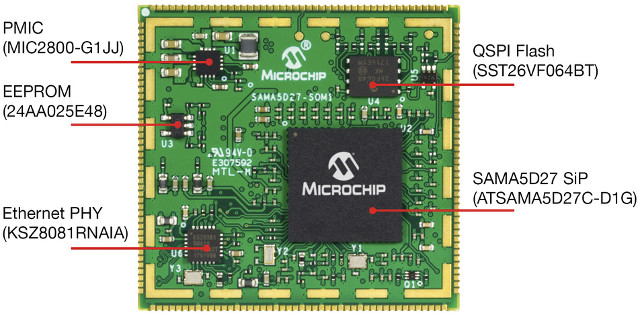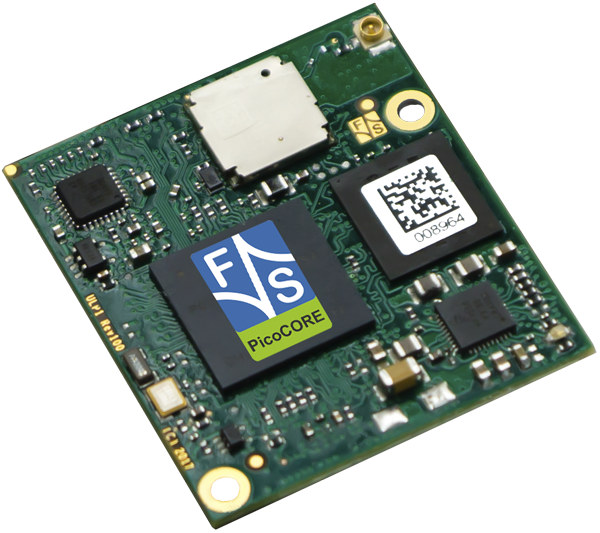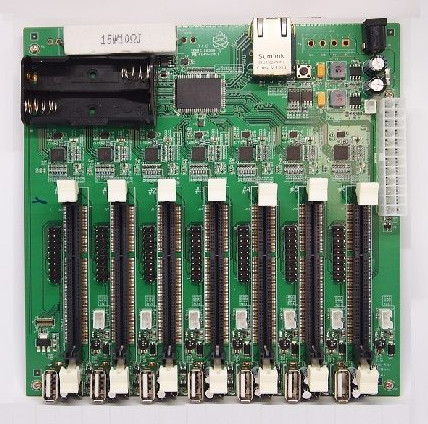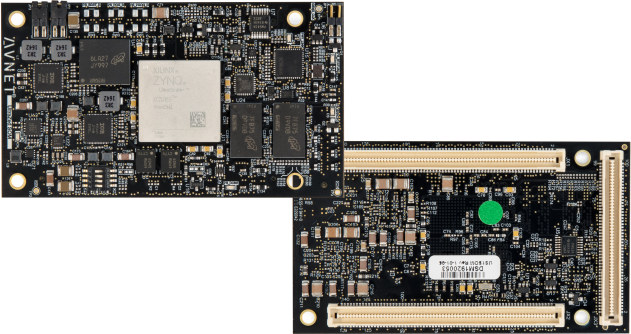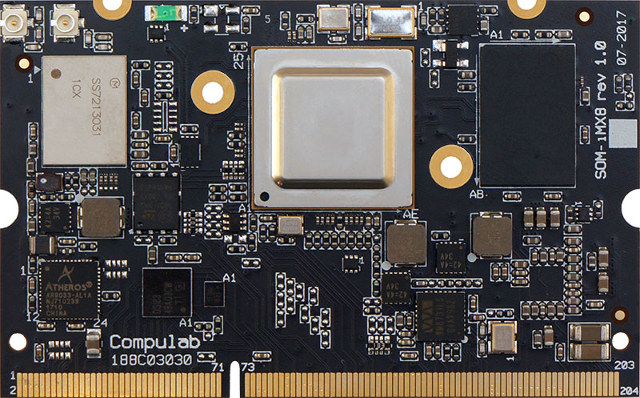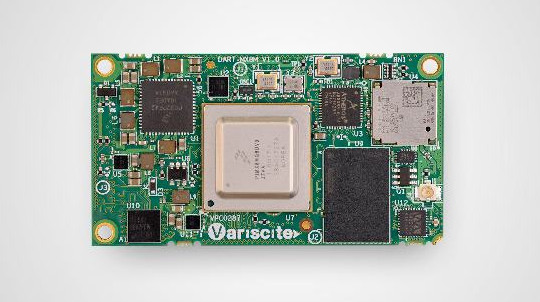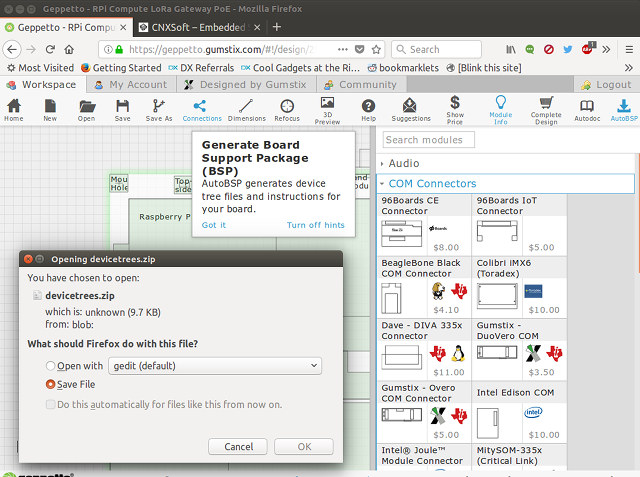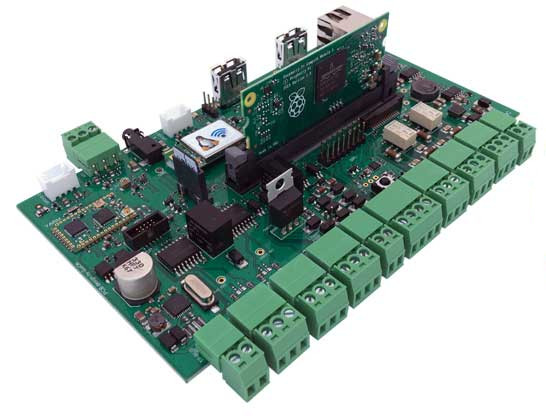Last fall, Microchip introduced four SAMA5D2 systems-in-package (SiP) combining the Cortex A5 processor with 16 to 128 MB DDR2 in a single package, and at the time, the company also offered ATSAMA5D27-SOM1-EK1, a fast prototyping and evaluation platform for the SiP that was designed with a baseboard and a soldered down ATSAMA5D27-SOM1 system-on-module. The kit was available for $245, and pricing for the SiP started at around $9 per unit for 5K order. The company has now started to offer ATSAMA5D27-SOM1 module separately with pricing starting at $39 each for 100 pieces order. ATSAMA5D27-SOM1 specifications: SiP – Microchip ATSAMA5D27C-D1G SiP with Cortex-A5 MPU @ 500 MHz, 128 MB DDR2 DRAM Storage Microchip SST26VF064BT 64Mb Serial Quad I/O (QSPI) flash memory for boot code (Linux kernel or RTOS) Microchip 24AA025E48 2Kb Serial EEPROM with EUI-48 Note Identity for the Ethernet MAC address Connectivity – Microchip KSZ8081RNAIA 10Base-T/100Base-TX Ethernet PHY for wired […]
PicoCORE MX7ULP is a Compact Module Based on NXP i.MX 7ULP Ultra Low Power Processor
NXP unveiled another variant of their i.MX 7 Cortex A7 processor last year, and I missed it. NXP i.MX 7ULP offers many of the same features as i.MX 7, but is manufactured using FD-SOI (Fully Depleted Silicon On Insulator) process technology to offer lower power consumption, as low as 15 mW or less in deep sleep, or 17 times less in comparison to i.MX 7 devices, while the dynamic power efficiency is improved by 50 percent on the real time domain (Cortex-M4). I found out about it thanks to an email from F&S Elektronik Systeme about the introduction of their PicoCORE MX7ULP module – based on i.MX 7ULP processor – at the Embedded World 2018 conference. PicoCORE MX7ULP CoM specifications: SoC – NXP i.MX 7ULP Arm Cortex-A7 processor @ up to 800 MHz, with Arm Cortex-M4 real-time core, and 2D/3D graphics accelerator System Memory – Up to 1GB LPDDR3 Storage […]
Pine64 ClusterBoard is Now Available for $100 with one Free SOPINE A64 System-on-Module
We’ve previously reported Pine64 had developed “Sopine Clusterboard” for a specific project with support for up to seven SOPINE A64 SoMs powered by Allwinner A64 quad core Cortex A53 processor. At the time (August 2017), it was unclear whether the company would sell to the solution publicly, but they’ve now gone ahead and launched Pine64 ClusterBoard for $99.99 plus shipping, including one free SOPINE A64 module for a limited time. PINE64 ClusterBoard specifications: SoM Slots – 7x SO-DIMM slot for SOPINE A64 modules Connectivity 1x Gigabit Ethernet port (RJ45) All SoMs are connected via Gigabit Ethernet using 7x RTL8211E transceivers and RTL8370N network switch (See diagram below) USB – 7x USB 2.0 port, one per SoM Expansion – Headers for each SoM with UART (serial console), I2C, key ADC, GPIOs, SPI, RESET/POWER 5V and GND Misc – RTC, reset button, optional EEPROM connected to RTL8370N Power Supply 5V/15A via power barrel […]
UltraZed-EG SoM and Starter Kit Feature Xilinx Zynq UltraScale+ ZU3EG MPSoC
Xilinx Zynq UltraScale+ Arm Cortex A53 + FPGA MPSoCs were announced in 2015, with actual products launched in early 2017 such as AXIOM development board or Trenz Electronic TE0808 UltraSOM+ system-on-module which are based on the ZU9EG model, and cost several thousand dollars. Recently, I wrote about Mycroft Mark II smart speaker based on a “quad core Xilinx processor”, and initially I assumed it was an Zynq UltraScale+ MPSoCs since those are the only Xilinx “quad core processors” I know of, but now I think it must be an unannounced part, since the company can’t provide the exact part number, and the price would be too low. Nevertheless, this lead me to check out if there was any lower cost boards based Xilinx Zynq UltraScale+ MPSoC with four Arm Cortex A53 cores, and ZU2EG is the entry-level part that matches this description. I could not find a ZU2EG development board, […]
Compulab CL-SOM-iMX8 SoM Features NXP i.MX 8M Processor for $68 and Up
I just covered one of the i.MX 8M systems-on-module last Friday with Variscite DART-MX8M SoM, but Variscite is not the only company about to launch such modules, and today I’ll have a look at Compulab CL-SOM-iMX8 system-on-module based on the same NXP i.MX 8M dual or quad core Cortex A53 processor. Compulab’s SoM comes with up to 4GB RAM, 64GB eMMC flash, an optional WiFi & Bluetooth module, as well as optional support for Ethernet, LVDS, analog audio, and more. Contrary to most competitors, the company has also made an habit of releasing detailed pricing the basic configuration and per option. But first, let’s go through the specifications: SoC (one of the other) NXP i.MX8M Quad quad core Arm Cortex-A53 processor @ 1.5GHz with Arm Corex-M4 real-time core, Vivante GC7000Lite GPU supporting OpenGL ES 3.1, Open CL 1.2 and Vulkan NXP i.MX8M Dual dual core Arm Cortex-A53 processor @ 1.5GHz […]
Variscite DART-MX8M is a Compact NXP i.MX 8M System-on-Module
NXP has recently launched their i.MX 8M evaluation kit and released documentation, so we can expect multiple products based on the family in 2018. The new NXP i.MX 64-bit processors include three families with i.MX 8, i.MX 8X, and i.MX 8M, but so far it looks like many companies are launching products based on the latter. The Embedded World Conference 2018 at the end of February should be the occasion for many product launches, especially systems-on-module and related development kit, but several companies have already posted information about their i.MX 8(M) modules minus pricing, and one of those is Variscite DART MX8M a company (55x30mm) module with i.MX 8M processor, up to 4GB LPDDR4, up to 64GB eMMC flash, as well as 802.11ac WiFi and Bluetooth 4.0. Variscite DART-MX8M specifications: SoC – NXP i.MX8M with dual or quad core Cortex A53 processor @ up to 1.5 GHz, Cortex-M4 real-time core […]
Gumstix AutoBSP Automatically Generates Device Tree Files for Hardware Designed with Geppetto
Gumstix launched Geppetto Design-To-Order (D2O) system back in 2013, and at the time you could design complete baseboard for their Overo CoMs right in your Chrome or Firefox web browser, and once complete, order the board from the website. The system is meant to save you time, and “design” here does not mean drawing schematics, and laying out PCBs, but instead selecting board size, and adding ports as needed. Since then, the company has added support for more modules, and you can now easily build you own baseboard for Raspberry Pi Compute Module, Technexion PICO-IMX6 module, Toradex Colibri SoM, 96Boards Mezzanine, and they even have Beaglebone Black and 96Board CE or IoT connectors, among others. Support for Qualcomm DragonBoard 410c, Atmel (Arduino) , and STMicro platforms is also being worked on. Their latest feature – AutoBSP – automatically generates device tree files for your custom boards, so you can simply […]
Acme CM3-Home is a Raspberry Pi 3 Compatible Board Designed for Home Automation
Raspberry Pi CM3 & CM3L modules are used in so many devices it’s hard to keep up. From NEC digital signage displays, to industrial touch panels, and IoT gateways, the Broadcom BCM2837 based system-on-module are found in more and more products and solutions, and number of announcements seems to have increased over the last few months. The latest product to leverage Raspberry Pi CM3L SoM is made by Italy based Acme Systems, and designed for home automation. CM3-HOME comes with opt0-isolated inputs compatible with KNX and DALI buses, various connectivity options (Ethernet, WiFi, Bluetooth, 868MHz ISM radio…), and other expansion port. Two edition of the boards are available: LITE and FULL, with the former suitable for most home automation project, and the latter adding support for some commercial lighting systems and energy harvesting Radio ISM nodes. Acme CM3-Home specifications: 200-pin SODIMM Module Slot compatible with Raspberry Pi CM3 / CM3L […]


